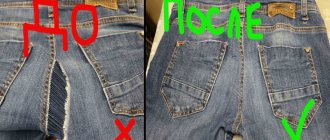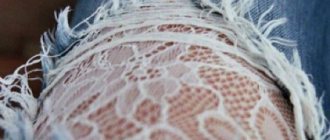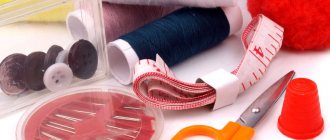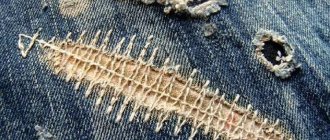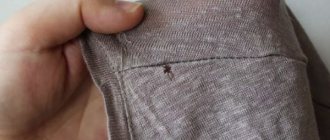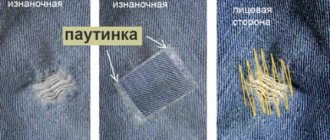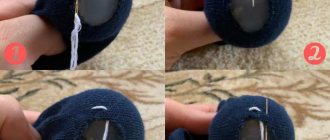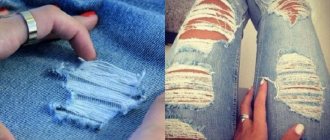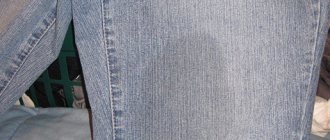The fashion of recent years involves wide and slightly “torn” clothes. Most often this concerns pants, namely jeans. Young people specifically buy such models with torn and frayed trouser legs at the knees. It happens that regular jeans tear in similar places. Some people are happy about this, and some are not. In addition, it may happen that the pants come apart in a completely inappropriate place.
In this case, the jeans will need to be sewn up and patches applied. Sometimes the only salvation will be a thorough darning of jeans on a sewing machine. The material will tell you how to sew up a hole in jeans beautifully and how to darn with a sewing machine in case of some unpleasant situations.
The fashion for torn pants is in its heyday
Types of holes on jeans
Jeans, which were originally workers' clothing, began to be worn by people all over the world due to their qualities. They are constantly added to collections by some of the most popular fashion designers. Denim has almost completely replaced any other materials for sewing pants. Even old denim is strong and wear-resistant, but this does not always protect against damage in the form of holes and seams coming apart in certain places. Most often this happens:
- On your knees;
- Between the legs;
- On and in your pocket;
- On the butt.
Small hole in pocket
Important! Jeans are demi-season clothing and from constant wear, regardless of their quality, they can tear and wear out in certain places where friction most often occurs. And it most often occurs on the inner thighs, on the knees and at the very bottom along the hem.
Pants worn between legs
DIY application
A lot of pleasure comes from work when you have to show your imagination. Make the applique with your own hands, then the new thing will be a joy for you!
Make an applique out of leather, because denim and leather look very original.
You can use fabric of a different color, beads, braid, multi-colored buttons . Girls can even use lace .
Floral motifs look elegant , and ethnic motifs add style. Favorite butterflies and fish will turn your pants into a cute, cozy little thing. And gold will give jeans a unique charm.
Sew a pocket onto your knee! Have no idea how to do this? Place the applique on a piece of denim, then sew it onto the hole in the form of a pocket. It will be very beautiful, and the functionality of the jeans will increase a little. One more pocket will not be superfluous.
Dear friends, knowing how to sew up jeans at the knee, you can create for yourself more than one original thing that will diversify your wardrobe.
Instructions for proper stitching
If a person has never darned holes in his pants, then it would be ideal to read the instructions on this matter. One of them will be presented below. Having completed all these points, you can easily learn how to sew up a hole in your pants unnoticed. Actually instructions:
- Choose threads whose color should be invisible against the background color of the fabric. You should also choose the right and thick needle. Thin and small needles are not suitable for denim;
- Thread a thread through a needle and tie a knot at its end, or better yet several knots in one place;
- Sew the hole from the wrong side, tightening the thread as tightly as possible. You need to sew close to the edge of the seams of the holes;
- During the darning process, you should constantly look at the front side of the fabric so that the seam is smooth and beautiful;
- Make a few additional knots so that the seam does not come undone when worn, and cut off the rest of the thread.
You might be interested in: Making simple patterns for wraparound robes
Darning technique
We sew by hand
If the hole turns out to be a straight or angular cut, then you can simply and efficiently darn on a sewing machine, for example, the popular Janome. To start the process, you need to choose the color and shade of thread that is suitable for darning jeans. Next, you need to make several stitches, which should be the same in size, as well as the tension of the individual threads. If these rules are not followed, the torn hole will look worse than before repair. It turns out that sewing up a hole in jeans without being noticed is quite simple.
Torn knees with torn edges
Important! If we are talking about repairing children's or women's clothes, then you can apply appliqués, patches on top, or decorate the repair as an element of clothing design.
Applique on pocket
How to sew without a machine
The easiest way to sew up any type of hole in jeans without using a sewing machine is to simply darn or apply a patch. You can create decor around and on the hole not only with the help of various denim and non-denim fabrics and buttons, but also with other accessories and ribbon. It is better not to repair children's and thin pants in this way, since the hole may tear even more, but use hand sewing on a piece of other denim. In general, the same instructions described above will work for mending a hole.
Hand stitching technique
Tools for work
Their choice depends on whether the product will have to be darned manually or by machine. If you have to sew it up by hand, you need to take a household needle of a suitable size. The packaging with needles indicates their thickness and what material they are intended for. For denim, 11 or 14 works well. In order for the thread to insert well, its size must match the needle. The threads must be strong so that the mended hole does not come apart again after a short time. The size of cotton thread is suitable for sewing 50-80, synthetic - 50-60. It is better to use polyester threads. They stretch well and can withstand heavy loads.
Also useful for work:
- scissors;
- pins;
- unnecessary jeans or a scrap of fabric of the same color.
How to mend jeans between the legs using a machine
Holes between the legs are one of the most common problems with pants. It is in these places that the maximum friction of the trouser legs occurs, which is the main reason for the appearance of tears. As you already know: you can darn using a machine or by hand. The manual option has already been considered, so it is worth examining in detail the process of darning with a machine.
Invisible stitching
To do this you need:
- Set the “Straight stitch” mode on the machine;
- Next, the fabric should be compacted by tightly pressing the edges of the material to each other and making parallel lines using a foot;
- Steam the darning area so that it becomes almost invisible to the human eye.
Darning foot
Large holes cannot be sewn up this way, but if the fabric has just begun to unravel, this will help it maintain its appearance and gain additional density in this place.
You might be interested in Sewing a belt for skirts with a zipper yourself
Application on the knee
How to make a patch between your legs
You can solve the problem of jeans frayed between your legs with patches. This method requires having any denim material on hand. It is better to use the same material that remains after shortening the jeans or a spare piece that comes with the pants.
A pocket torn at the seam can be repaired discreetly
How to sew a patch on jeans between the legs? In general, the following actions are performed:
- Searching for suitable fabric by color, shade and texture, if there is no original one;
- Laying out your pants so that the hole is clearly visible;
- Cutting off the required piece of fabric and stitching it on a machine;
- Turn the jeans inside out and apply the patch facing inside out;
- Sew a patch along the contour;
- Turn the pants inside out and sew them right side together.
A beautiful applique can save a thing
. Important! To repair jeans in intimate areas, you can also use ready-made applications and patches. They do not need edge processing and have various shapes and contain drawings.
Some models already contain drawings
Jeans repair (thing)
Often people get used to their favorite, comfortable things and do not want to part with them.
Over time, clothing wears out and becomes unusable. Today I will tell you how to “extend the life” of ordinary jeans and show you how to beautifully mend frayed and torn areas. The best way to restore jeans is with a gizmo. Essentially, quilting is the restoration of fabric using stitches from a sewing machine. I have a great sample of jeans with different rips and for me this is an opportunity to show different versions of the piece on one trouser, which will be in different places.
First, I select the appropriate fabric for the patches that will be attached to the wrong side of the jeans. For light and thin jeans, you can use light or dark dublerin (this is a fabric-based adhesive) of medium-thin density. For warm and thick jeans, I usually choose denim patches. When choosing a color, you can use the wrong side.
So I have:
- Two identical wear marks located at the bottom of the rear patch pockets.
- There is a tear on the side of the back patch pocket.
- A very common fray in jeans is between the legs.
In total I have 4 places on which I will sew invisible patches using the stitching method.
For cases 1 and 2, from the selected pieces I cut out circles slightly larger than the rubs themselves. On the back halves of the trousers, I use the patches on the wrong side and finish the edges with an overlocker.
For option 3 - I use the front side of the denim patches and cut out one patch that covers two tears between the legs and also process it with an overlocker.
On the back halves I rip open the patch pockets in the right places. My thing will be placed under the pockets.
Then you need to attach the patches to the inside of the jeans. For this I use paper-based adhesive web. Using an iron, I glue it to the desired side of the patches, and then to the trousers, respectively. Here you need to not confuse which patches were selected and which side. To glue patches, you can use cobwebs without a paper backing.
How invisible our patch will be mainly depends on well-chosen thread colors . As you know, jeans are often of uneven color - in some places they are darker or lighter, so we select threads for a specific place.
1 option (left pocket at the bottom and a gap on the side of the right pocket)
For piecing, I set the stitch size to small. The jeans that I initially repair (for decoration) had abrasions made by the manufacturer, so I do a loose piece on the back halves using zigzag machine stitches along the inclination of the hem of the fabric, thereby preserving the design of the trousers.
Option 2 (right pocket, bottom)
For comparison, on the right pocket, I make a loose piece with vertical zigzags (I place the machine stitches vertically, not along the hem of the fabric). In my opinion, this option is less noticeable. Very often I use this thing on the knees of jeans (if the gap is not vertical).
Options 1 and 2 of the piece are called light, since the gap is not stitched solid. The patch fixes the tear or fraying and protects it from further tears, but remains visible for decorating the trousers.
Option 3 of the piece (between the legs) – dense. Here the machine stitches are superimposed very close to each other. This method is used for strength and to seal the gap. In my case, I sew up existing holes with thick stitches, and with a light stitch I go through thin places where there are no holes yet, but will soon be worn out.
General recommendations for darning jeans:
- In dense (thick) pieces, make machine stitches perpendicular to the gap (across) - this will be more reliable.
- So that the thing is not too rough and hard on the jeans. We apply stitches tightly only on obvious holes, capturing entire edges. Where they are not there - only a light thing, denser or less dense - here it is at your discretion. The inclination of the lines is the same as that of a dense piece.
- After washing, the glued patches will come off, so I initially make sure that they are secured with stitches. Sometimes at this moment, as needed, I add threads of a different desired color. On the inside it looks like this:
We select the color of the threads and sew the back pockets. The photo of the finished item was not very good, but it shows the mended areas under the pockets. On the right half, under the patch pocket, the repair is almost invisible (photo 1 at the very top of the article).
Darning is a common repair on jeans. The more you do it, the more experience you will gain and the better it will turn out. Good luck!
How to remove a hole in your butt
For abrasion holes on the butt that are clearly visible, appliqués and embroidery will probably be the only beautiful solutions. The butt is the area of the body to which the eye's attention is drawn much more often than to the knees, so this is a reason to make a few additional patterns embroidered with thick threads. The main rule here is that you don’t need to make one application, as everything will immediately become noticeable.
Even if there is only one hole, you should stitch several applications, arranged in a chaotic order. This will not only repair your pants, but will also give them life back and make them stylish. One “patch” will immediately reveal the torn area.
Even disheveled holes can be tidied up
How to remove a hole in a pocket
To repair jeans torn in the front, side or back pockets, the same methods are used: beautiful embroidery, patches on the inside, appliqués. A patch is ideal for side and front pockets, and embroidery is indispensable for the back pocket. However, you can also use just one applique, since the pocket does not need a total design, unlike a “torn” butt.
Straight stitch result
How to sew on a knee
If a section of tissue on the knee is damaged, there are two repair options:
- Classic darning of jeans. For this you need special threads, scissors, a thick needle, and a thimble if possible. The cut or tear is sewn up with tight and small stitches, first in a horizontal and then in a vertical position;
- Decorating a cut or hole. For this you need appliqués, threads, a needle, a thimble, an iron, scissors, and thermal tape. The process is as follows: an applique is applied to the hole and ironed well. If the design does not have its own adhesive base, then you need to “plant” it on special glue or thermal tape. To prevent the applique from falling off during wearing or washing, you can sew it on with threads.
You might be interested in what can be made from velvet: cutting rules
Embroidery can also save pants
How to quickly close torn areas if there is no time
The process of darning jeans or sewing on a patch takes a long time or requires the use of a sewing machine. If you don’t have the time and the necessary equipment, you can decorate the damaged area on your knee with a sticker made of Swarovski crystals.
There are ready-made drawings on sale; they are the easiest to work with. It is enough to choose a drawing of a suitable theme and size. You can buy rhinestones coated with adhesive and make a design out of them yourself.
All work takes place in several steps:
- The damaged area is cut out. A patch of similar fabric is placed underneath.
- The edges of the lower part are glued with adhesive web or sewn around the perimeter.
- A pattern of rhinestones is laid out on the area to be covered. Cover with a piece of fabric and fix the temperature of the iron.
- The trousers are turned inside out and the area to be treated is carefully ironed from the wrong side.
Thermal patches are a kind of lifesaver when you don’t have enough time for lengthy repairs. The procedure for working with them is the same as with a pattern made of rhinestones. The quality of the repair depends on the mode of the iron and the time of its exposure. You can check the quality of gluing after the area being ironed has completely cooled.
Ways to avoid scuffs
All of the above can be avoided if you take care of your things, wash and wear them correctly. If a person buys jeans that fit close to him, then he needs to be prepared that sooner or later, especially after washing, they may tear on the butt, knees and other places.
Embroidery on pants has long been in fashion
If the jeans are low-waisted, they tend to fray on the inner thighs. In order to avoid all the unpleasant moments, you should buy jeans strictly according to your size. Don't expect the fabric to stretch during wear. Not all fabrics stretch to the required size.
Completely torn pants are stylish
Thus, sewing up jeans is not difficult. You can do this either manually or using a machine. Darning on a sewing machine has a number of advantages: speed, operating modes and quality of seams, but it is also quite possible to do it by hand. This action can give your old favorite item a second life and make it more stylish. To prevent your pants from getting washed between your legs and from tearing from taking unexpected poses, you need to select them exactly according to your size.
